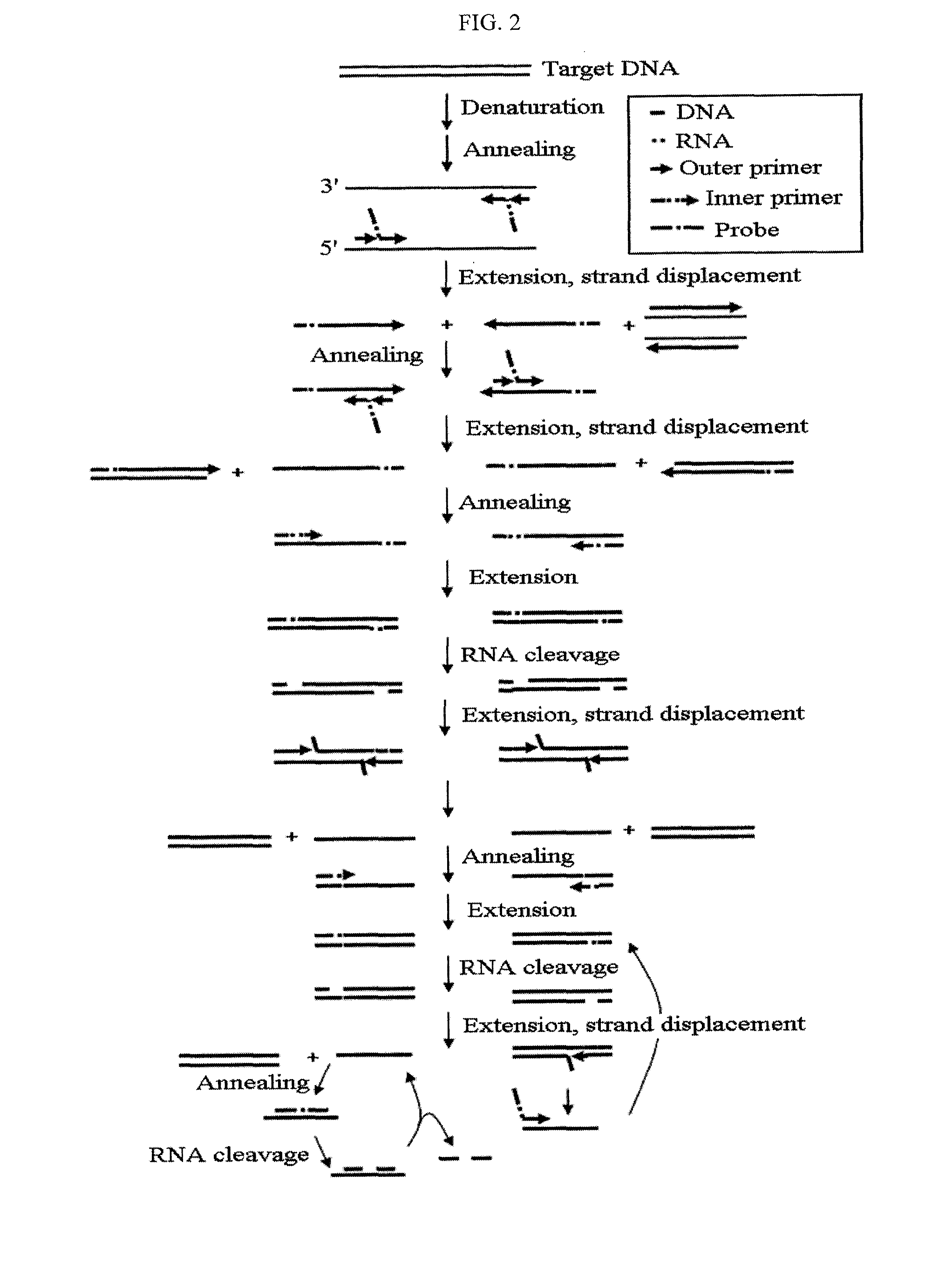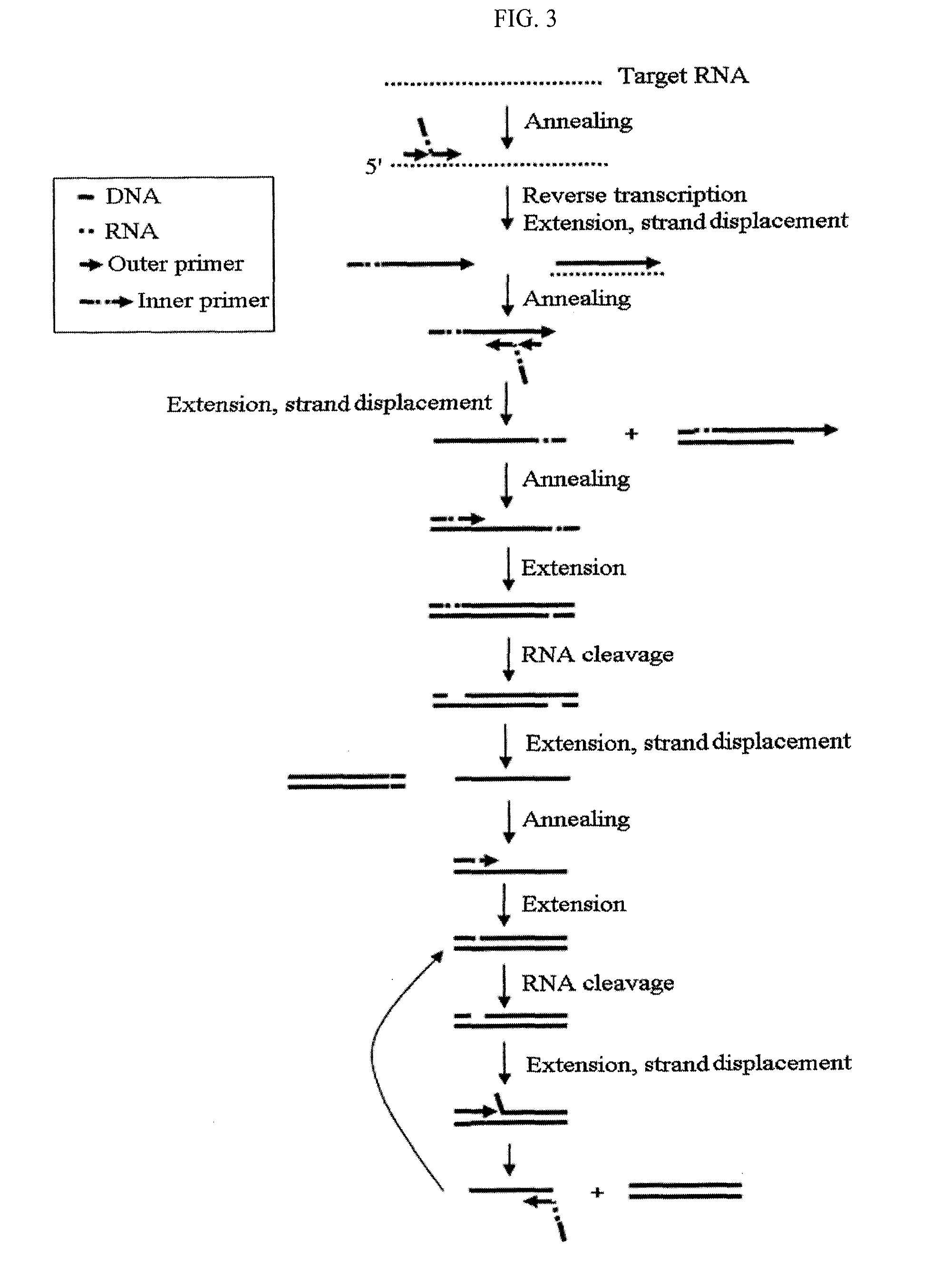Method for detecting nucleic acids by simultaneous isothermal amplification of nucleic acids and signal probe
a signal probe and nucleic acid technology, applied in the field of isothermal amplification of nucleic acids and signal probes, can solve the problems of low copy number, slow reaction rate, difficulty in solving,
- Summary
- Abstract
- Description
- Claims
- Application Information
AI Technical Summary
Benefits of technology
Problems solved by technology
Method used
Image
Examples
example 1
Isothermal Amplification of DNA
[0069]Chlamydia trachomatis (ATCC VR-887) DNA was used as target nucleic acids. Genomic DNA was extracted from Chlamydia trachomatis which is gram negative bacteria using G-spin™ Genomic DNA extraction Kit (iNtRON Biotechnology, Cat. No. 17121), then subjected to amplification. For the genomic DNA extraction, 500 mL of the bacterial suspension was centrifuged at 13,000 rpm for 1 min and the supernatant was removed then, 500 mL of PBS (pH 7.2) was added thereto, followed by centrifuging to remove supernatant. Then, cell pellets were suspended by adding 300 mL of G-buffer solution containing RNase A and Proteinase K, and left to stand at 65° C. for 15 min, then 250 mL of binding buffer solution was added thereto to mix thoroughly, followed by binding DNA to a spin column. After that, 500 mL of washing buffer A was added to the spin column and centrifuged at 13,000 rpm for 1 min to wash, and 500 mL of washing buffer B was added to the spin column to centr...
example 2
DNA Detection by Enzyme-Immunoassay
[0078]170 ml of PBST binding buffer was added to the amplification product obtained in Example 1 to prepare a reaction mixture consisting of the following components: 136 mM of NaCl, 2.7 mM of KCl, 8.1 mM of Na2HPO4, 1.5 mM KH2PO4, 0.05% Tween 20, 1 / 7000 diluted anti-F—HRP (Perkin Elmer, horseradish peroxidase conjugated anti-fluorescent antibody). The reaction mixture was transferred to streptavidin-coated microplate wells (Roche), and allowed to react for 10 min at 37° C. and 200 rpm. The supernatant in each well was removed and each well was added with 300 ml of PBST washing buffer to wash, wherein the PBST washing buffer has the same composition as that of the above binding buffer except for the antibody removed therefrom. After washing, each well was added with 200 ml of HRP substrate, 3,3′,5,5′-tetramethylbenzidine (Bio-Rad, TMB), and incubated for 5 min in a dark place to result in color development, then added with 100 ml of 1N H2SO4 to sto...
example 3
DNA Detection by Lateral-Flow Chromatography
[0080]10 ml gold colloid solution (Chemicon) with a diameter of 40 nm was added to 100 mg streptavidin (Sigma), and vortexed for 2 min, then allowed to react for 3 hr. Then, 1 mL of 1% BSA (dissolved in 2 mM borate) solution was added to the resulting mixture to centrifuge at 10,000 rpm for 15 min at 4° C. and supernatant was removed, then 1 mL of 2 mM borate buffer solution was added to the resultant from which the supernatant was removed to wash 3 times, followed by adding 1% BSA (dissolved in 2 mM borate) to resuspend.
[0081]Gold conjugate solution was stored at 4° C. with an absorbance value of 10 at 520 nm, and used by diluting to an appropriate ratio. Fluorescein antibody (Chemicon) was coated as a test line and biotin-conjugated casein (Biofocus) was coated as a control line on a nitrocellulose membrane, respectively.
[0082]60 mL of gold conjugate solution diluted 1:50 with a running buffer (1×PBS, 1% Triton X-100, 0.6% BSA) was added...
PUM
| Property | Measurement | Unit |
|---|---|---|
| temperature | aaaaa | aaaaa |
| pH | aaaaa | aaaaa |
| pH | aaaaa | aaaaa |
Abstract
Description
Claims
Application Information
 Login to View More
Login to View More - R&D
- Intellectual Property
- Life Sciences
- Materials
- Tech Scout
- Unparalleled Data Quality
- Higher Quality Content
- 60% Fewer Hallucinations
Browse by: Latest US Patents, China's latest patents, Technical Efficacy Thesaurus, Application Domain, Technology Topic, Popular Technical Reports.
© 2025 PatSnap. All rights reserved.Legal|Privacy policy|Modern Slavery Act Transparency Statement|Sitemap|About US| Contact US: help@patsnap.com



